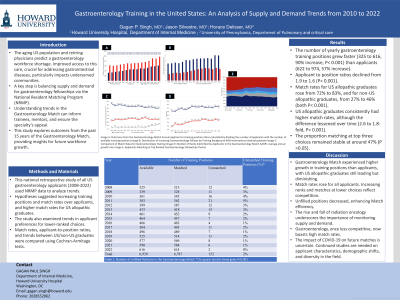Tuesday Poster Session
Category: Practice Management
P4045 - Gastroenterology Training in the United States: An Analysis of Supply and Demand Trends from 2010 to 2022
Tuesday, October 24, 2023
10:30 AM - 4:00 PM PT
Location: Exhibit Hall

Has Audio

Gagan P. Singh, MD
Howard University Hospital
Washington, DC
Presenting Author(s)
Gagan P. Singh, MD1, Jason Silvestre, MD1, Horace Delisser, MD2
1Howard University Hospital, Washington, DC; 2University of Pennsylvania, Philadelphia, PA
Introduction: The aging US population and retiring physicians predict a gastroenterology workforce shortage. Improved access to this care, crucial for addressing gastrointestinal diseases, particularly impacts underserved communities. A key step is balancing supply and demand for gastroenterology fellowships via the National Resident Matching Program (NRMP). Understanding trends in the Gastroenterology Match can inform trainees, mentors, and ensure the specialty's appeal. This study explores outcomes from the past 15 years of the Gastroenterology Match, providing insights for future workforce growth.
Methods:
This national retrospective study of all US gastroenterology applicants (2008-2022) used NRMP data to analyze trends. Hypotheses suggested increasing training positions and match rates over applicants, and higher match rates for US allopathic graduates. The study also examined trends in applicant preferences for lower-ranked choices. Match rates, applicant-to-position ratios, and trends between US/non-US graduates were compared using Cochran-Armitage tests.
Results: The number of yearly gastroenterology training positions grew faster (325 to 616, 90% increase, P< 0.001) than applicants (622 to 974, 57% increase). Applicant to position ratios declined from 1.9 to 1.6 (P< 0.001). Match rates for US allopathic graduates rose from 72% to 83%, and for non-US allopathic graduates, from 27% to 46% (both P< 0.001). US allopathic graduates consistently had higher match rates, although the difference lessened over time (2.6 to 1.8-fold, P< 0.001). The proportion matching at top three choices remained stable at around 47% (P >0.05). The percentage of unmatched positions fell from 4% to 0.3% (P< 0.001).
Discussion:
Gastroenterology Match experienced higher growth in training positions than applicants, with US allopathic graduates still leading but diminishing. Match rates rose for all applicants. Increasing ranks and matches at lower choices reflect competition. Unfilled positions decreased, enhancing Match efficiency. The rise and fall of radiation oncology underscores the importance of monitoring supply and demand. Gastroenterology, once less competitive, now boasts high match rates. The impact of COVID-19 on future matches is uncertain. Continued studies are needed on applicant characteristics, demographic shifts, and diversity in the field.

Disclosures:
Gagan P. Singh, MD1, Jason Silvestre, MD1, Horace Delisser, MD2. P4045 - Gastroenterology Training in the United States: An Analysis of Supply and Demand Trends from 2010 to 2022, ACG 2023 Annual Scientific Meeting Abstracts. Vancouver, BC, Canada: American College of Gastroenterology.
1Howard University Hospital, Washington, DC; 2University of Pennsylvania, Philadelphia, PA
Introduction: The aging US population and retiring physicians predict a gastroenterology workforce shortage. Improved access to this care, crucial for addressing gastrointestinal diseases, particularly impacts underserved communities. A key step is balancing supply and demand for gastroenterology fellowships via the National Resident Matching Program (NRMP). Understanding trends in the Gastroenterology Match can inform trainees, mentors, and ensure the specialty's appeal. This study explores outcomes from the past 15 years of the Gastroenterology Match, providing insights for future workforce growth.
Methods:
This national retrospective study of all US gastroenterology applicants (2008-2022) used NRMP data to analyze trends. Hypotheses suggested increasing training positions and match rates over applicants, and higher match rates for US allopathic graduates. The study also examined trends in applicant preferences for lower-ranked choices. Match rates, applicant-to-position ratios, and trends between US/non-US graduates were compared using Cochran-Armitage tests.
Results: The number of yearly gastroenterology training positions grew faster (325 to 616, 90% increase, P< 0.001) than applicants (622 to 974, 57% increase). Applicant to position ratios declined from 1.9 to 1.6 (P< 0.001). Match rates for US allopathic graduates rose from 72% to 83%, and for non-US allopathic graduates, from 27% to 46% (both P< 0.001). US allopathic graduates consistently had higher match rates, although the difference lessened over time (2.6 to 1.8-fold, P< 0.001). The proportion matching at top three choices remained stable at around 47% (P >0.05). The percentage of unmatched positions fell from 4% to 0.3% (P< 0.001).
Discussion:
Gastroenterology Match experienced higher growth in training positions than applicants, with US allopathic graduates still leading but diminishing. Match rates rose for all applicants. Increasing ranks and matches at lower choices reflect competition. Unfilled positions decreased, enhancing Match efficiency. The rise and fall of radiation oncology underscores the importance of monitoring supply and demand. Gastroenterology, once less competitive, now boasts high match rates. The impact of COVID-19 on future matches is uncertain. Continued studies are needed on applicant characteristics, demographic shifts, and diversity in the field.

Figure: Image A: Outcomes from the Gastroenterology Match
Annual applicant to training position ratios calculated by dividing the number of applicants with the number of available training positions
Image B: Distribution of Incoming Gastroenterology Fellows by Training Background
IMG=international medical graduate
Image C: Comparison of Match Rates for Gastroenterology Training
Image D: Number of Ranks Submitted by Applicants in the Gastroenterology Match
AAGR= average annual growth rate
Image E: Applicants Matching at Top Ranked Gastroenterology Fellowship Choices
Annual applicant to training position ratios calculated by dividing the number of applicants with the number of available training positions
Image B: Distribution of Incoming Gastroenterology Fellows by Training Background
IMG=international medical graduate
Image C: Comparison of Match Rates for Gastroenterology Training
Image D: Number of Ranks Submitted by Applicants in the Gastroenterology Match
AAGR= average annual growth rate
Image E: Applicants Matching at Top Ranked Gastroenterology Fellowship Choices
Disclosures:
Gagan Singh indicated no relevant financial relationships.
Jason Silvestre indicated no relevant financial relationships.
Horace Delisser indicated no relevant financial relationships.
Gagan P. Singh, MD1, Jason Silvestre, MD1, Horace Delisser, MD2. P4045 - Gastroenterology Training in the United States: An Analysis of Supply and Demand Trends from 2010 to 2022, ACG 2023 Annual Scientific Meeting Abstracts. Vancouver, BC, Canada: American College of Gastroenterology.
